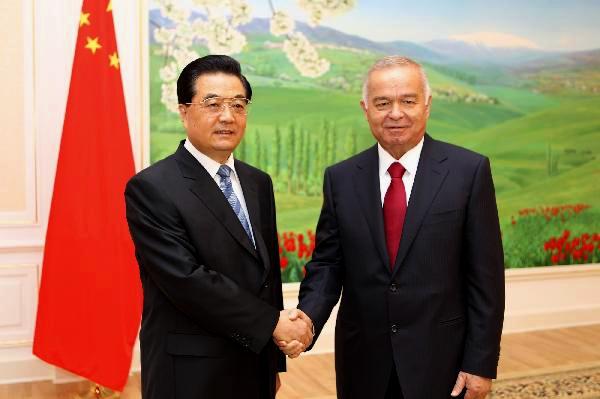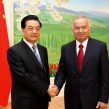
China’s Economic Strategies for Uzbekistan and Central Asia: Building Roads to Afghan Strategic Resources and Beyond
Publication: Eurasia Daily Monitor Volume: 9 Issue: 172
By:

Recent Chinese diplomatic maneuvers in Central Asia, both bilateral and multilateral, show that Beijing’s strategy treats the region as a corridor for reaching resource bases in Afghanistan, the Middle East and Africa. Central Asia is thus part of China’s broader blueprint of securing strategic resources and supplies to feed its developing economy (Z. Saipov, China Oil & Gas Monitor, Week 21, Issue 396, News Base, May 31, p. 3–4).
Illustratively, Chinese Vice Premier Hui Liangyu’s two-week official tour of Congo, Tanzania, Kyrgyzstan and Uzbekistan on September 1–13 (English.sina.com, September 6) supports the premise that Central Asia is to have an important role in Beijing’s energy strategy. While other global and regional powers contemplated and sketched out on paper their desired projects to slice up the Central Asian hydrocarbon pie, China quietly has found common language with the regional leaders and has been connecting the countries with oil and gas pipelines as well as air and land routes. In particular, Beijing succeeded in rapidly building and launching the Kazakhstan-China oil pipeline and the Turkmenistan-Uzbekistan-Kazakhstan-China gas pipeline. In all of these projects, China achieved its goals incrementally by inviting Uzbekistan only after nearing completing of the construction of its Central Asia-China gas pipeline, having built the necessary infrastructure first in Kazakhstan and then in Turkmenistan. Beijing apparently is playing the same shrewd strategy in Africa by visiting Congo and Tanzania—the eastern and western coasts of Central Africa—but not yet revealing its real motives. In the future, the upgraded infrastructure at these two end points probably will be connected with the African countries located in between.
By intensifying trade and economic relations with Central Asia, Beijing intends to develop its own periphery—its western provinces including Xinjiang—and extend and tie them to the wider region’s economies. In this respect, Chinese media reported that Xinjiang is expected to become China’s main logistics and information hub for rendering services to Central Asia. That Xinjiang is located at the heart of Eurasia, borders eight countries and has 17 official border crossings implies China’s desire to further boost this province’s external trade relations (Russian.cri.cn, September 11; Russian.china.org.cn, September 10–14).
On September 2, Chinese Premier Wen Jiabao, while inaugurating the second annual China-Eurasia Expo in Urumqi, called on Chinese businesses to intensify investment into Eurasian countries and study the possibility of creating new platforms for economic relations—the China–Central Asia Economic Cooperation Fund and the Fund on Agricultural Cooperation. In 2011, according to Chinese Customs, trade turnover between China and the five central Asian countries reached $16.98 billion; however, Chinese exports to the region totaled $12.49 billion and imports to Xinjiang equaled $4.49 billion (Russian.cri.cn, September 11; Inform.kz, September 12). In addition to serving direct air flights between the regional countries’ capitals, Xinjiang-based Chinese Southern Airlines also opened several routes to and from Urumqi, covering all the Central Asian republics (Russian.china.org.cn, September 17).
At present, Beijing is keenly interested in a speedy construction of a railroad to connect China, Kyrgyzstan and Uzbekistan. Thus, in Kyrgyzstan, Vice Premier Hui met President Almazbek Atambayev, and both sides underlined the strategic importance of building the China-Kyrgyzstan-Uzbekistan railroad as well as renovating the Bishkek-Naryn-Torugart and Osh-Irkeshtam-Sarytash highways (Russian.cri.cn, September 10).
The last stop in Hui’s tour was Uzbekistan. On the day of the Chinese official’s visit, President Islam Karimov signed into law “On Ratification of the Treaty on Long-Term Neighborhood, Friendship and Cooperation of the SCO countries” (Russian.cri.cn, September 13). Both sides also inked bilateral agreements worth $535 million (Iarex.ru, Uzinform.com, September 13). Reportedly, from August 2012, Uzbekistan also began supplying China with gas on a regular basis, and supply volumes may reach up to 4–5 billion cubic meters (bcm) by the end of 2012. By 2016, the volumes of Chinese-bound gas are planned to reach no less than 25 bcm annually (12news.uz, Oilru.com, September 13).
Trade and economic relations between China and Uzbekistan is shifting from a people-to-people to a state-to-state level. During President Karimov’s last visit to China on the sidelines of the SCO summit in June 2012, Uzbekistan and China reached over 30 trade, economic, investment and financial agreements worth $5.3 billion. They cover the hydrocarbon industry, cotton, uranium, gas, rare metals, and the production of chemical products, electronics, IT, telecommunications, pharmaceuticals and construction materials (Uzinform.uz, Uza.uz, Rosbalt.ru, June 8; Gazeta.uz, Anons.uz, September 12). This breadth of agreements suggests China may be aiming to balance its trade and economic relations with Uzbekistan vis-à-vis Kazakhstan as well as seeking to compete for power and regional influence with Russia.
Yet, Chinese interest in Central Asia is an extension of its interests beyond this strategically located region. Indeed, last fall, China won two major mineral resource extraction contracts in Afghanistan. These contracts play into the larger plans assiduously pursued by Beijing to extensively increase its presence throughout Central Asia and access the region’s strategic resources. According to the U.S. Geological Survey, volumes of undiscovered, technically recoverable, conventional petroleum resources for the Amu Darya Basin and Afghan–Tajik Basin regions of Afghanistan, Iran, Tajikistan, Turkmenistan and Uzbekistan were estimated at 962 million barrels of crude oil and 52 trillion cubic feet of natural gas (https://pubs.usgs.gov/fs/2011/3154).
In all countries mentioned above, China mostly is focusing on infrastructure building and natural resource extraction. While Chinese investments in oil, gas, rail and road infrastructure will certainly boost the economies of the countries in the region and may raise their international profile, the Central Asian republics actually have few alternatives for raising their socio-economic indicators besides accepting Beijing’s offers of knowledge and high tech industry transfers.
In the short- and medium-run, the countries of Central Asia will be better off thanks to the enhancement of their industries and level of their current technological base. But by lending a helping hand, Beijing is laying the foundation of its own primacy in the region in order to meet its growing energy demands for sustaining Chinese domestic development. With regard to the Central Asian countries, China may until now have been pursuing a strategy of appeasement and concession toward all of them given their pivotal geopolitical importance along the land routes linking several regions and continents. Hence, developing Central Asia and ensuring a Chinese presence in this region will enable Beijing to fulfill its wider desire to reach, exploit and transport rich, far-off resources back to the mainland.
Assuming China succeeds in fully implementing its long-term projects for Central Asia, the new, favorable status quo in the region may eliminate barriers for Beijing to project its power and widen its economic and politico-military influence over attractive, adjacent regions to the country’s southwest. At the same time, China’s partners in Central Asia will be able take advantage of diversified export routes to world energy markets, away from Russia and not dependent on any single transit path. In return, however, these Central Asian republics may increasingly be expected to play the role of a strategic rear guard and conduit for China as Beijing acts on its broader ambition of would-be global leadership.




